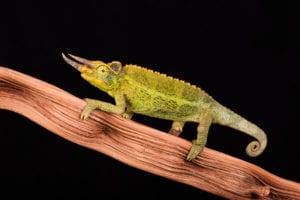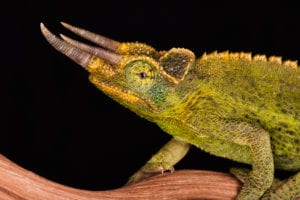A very desirable Chameleon species, a male Jacksons Chameleon is instantly recognisable with their three long horns. There are other species with three horns, but Jacksons are the one that are the species most people think of. They naturally occur in various regions throughout East Africa, but have been accidentally (or otherwise) introduced in at least three US States. There are three  sub-species Trioceros jacksonii xantholophus, Trioceros jacksonii jacksonii and Trioceros jacksonii merumontanus. The larger xantholophus (Yellow Crest) is the sub-species most likely encountered for sale. They are live bearers.
sub-species Trioceros jacksonii xantholophus, Trioceros jacksonii jacksonii and Trioceros jacksonii merumontanus. The larger xantholophus (Yellow Crest) is the sub-species most likely encountered for sale. They are live bearers.
A full account of captive care is far beyond a brief introduction such as this, however a quick run down of their basic needs and husbandry is in order – please research thoroughly before committing to this species. There are lots of keepers that favour mesh vivaria, however many of those keepers are fortunate to have several mesh vivaria in a dedicated room which is temperature and humidity controlled throughout. There are certainly advantages to using mesh vivaria, but for the person wanting one vivarium in their living room a mesh vivarium can introduce problems in this environment – for example temperature and humidity control. If a more conventional non-mesh vivarium is to be used ensure it is spacious and still has good airflow. A selection of branches and plants must be provided that are sturdy enough to allow climbing. It is essential that climbing branches are not permanently wet, this can cause feet sores. An ambient temperature of around 20-23C is ideal and provide a basking area at no more than around 25-26C – anything more will almost certainly cause stress related health issues. Heat can be provided with a variety of methods, each hotly debated in the hobby – this can vary from light producing heaters through to ceramic heaters. We have personally had success with ceramic heaters. Whichever heater is preferred it is critical to have a good thermostat to maintain the correct temperatures. UVB lighting is essential, we use high output T5 UVB tubes for twelve hours each day. Humidity needs to vary dependant on the time of day, night-time needs to be around 80% plus, day-time around 40-50%. Keep in mid airflow is essential, tiny fans installed in the  vivarium will help.
vivarium will help.
This species is insectivorous and they will eat virtually all commercially available livefood – crickets, locusts, cockroaches, waxworms etc. Gut-loading is essential, this means feeding the livefood that ultimately passes to the Chameleon – there are many commercially available livefood diets for this purpose. Supplementation is still necessary, calcium and a good quality balanced multi-vitamin must be dusted on the livefood prior to giving to the Chameleon. Do no allow over feeding, this can lead to picky feeding.
Overall, this fascinating and visually impressive species is not for everyone. Jacksons Chameleons are certainly more difficult to look after than Panther or Yemens Chameleon. With this in mind we would urge only experienced keepers take this challenge on, do not take keeping a more delicate species such as this lightly.
